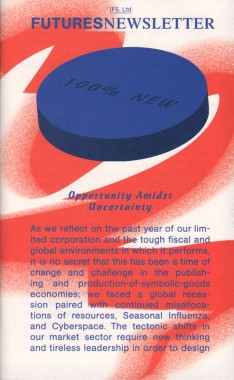
IFS, Ltd. Futures Newsletter, Opportunity Amidst Uncertainty
Softcover, 28 pp., offset 4/4, 110 x 175 mm
Edition of 6000
Published by IFS, Ltd. / Graphic Magazine
free* · out of stock
*free copy with each order
IFS, Ltd. Futures Newsletter is, in non-equal parts: a corporate bulletin, a speculative trading instrument, an experiment in memetic and symbiotic publishing, an internal-external analysis of company performance (B. Critton, H. Gassel, B. Griffiths, Z. Klauck, M. Nguyen), a proposal for an allegorical Escape Act (
S. Dockray), a bid for a series of six activities (
D. Horvitz), an abridged catalogue of semi-fictional gemstones (
L. Francescone), a profile of independent art book distributor (
Textfield, Inc.), and a self-reflexive / -reflective cartoon caption contest (
R. Rozendaal).
Investment Futures Strategy, Ltd. (United States) in partnership with GRAPHIC magazine (Korea) is pleased to introduce Futures, a semi-official newsletter published as a stand-alone supplement to GRAPHIC #17 (”When Design Becomes Attitude”). In lieu of a traditional contribution, IFS, Ltd. has chosen to use the GRAPHIC platform to continue its experiments in trade and publishing.
The Book Trust Prospectus examined new possibilities for funding, trade value, and distribution by attaching a different kind of significance to the object, thus short-circuiting the expected monetary transaction. Production of the Prospectus, however, relied on labor-intensive methods that required hours of input for a relatively small output. With the Futures newsletter, IFS, Ltd. has hybridized the positive aspects of large-scale corporate publishing — economies of scale or large print-runs, distribution of labor, and maximum efficiency — with the dictatorial authorship afforded by self-publishing. This new model maximizes potential as authors and designers while minimizing the opportunity cost of production and distribution.
Within the logic of IFS, Ltd. Futures will also act as a form of currency: readers can use their copy of the newsletter to trade for a copy of the Book Trust Prospectus. These recirculated copies of Futures will then be re-made available as a way to generate revenue for a future, freely distributed, as-yet-undefined project thus continuing the self-sustaining eco-system of publishing and distribution, one in which readers and producers collaborate to generate and circulate content outside of the cost-prohibitive channels of traditional publishing.
Art, Benjamin Critton, Brendan Griffiths, David Horvitz, Design, Distribution, Futures Newsletter, Graphic Magazine, Harry Gassel, IFS Ltd., Interview, Jonathan Maghen, Lauren Francescone, Lim Kyung Yong, Mylinh Nguyen, Na Kim, Nanette Sullano, Phil Chang, Rafael Rozendaal, Sean Dockray, Textfield, The Book Prospectus, Zak Klauck

Mono.Kultur 26, Manfred Eicher — Recording ECM
Softcover, 42 pp., offset 1/1, 200 x 150 mm
Edition of 5000
ISSN 1861-7085
Published by Mono.Kultur
$9.00 · out of stock
Born in 1943 in southern Germany, Manfred Eicher dedicated his life early on to music, learning violin as a child, and studying double bass and classical music at the Academy in Berlin. On parallel tracks, he pursued an equally traditional self-education in jazz: through relatives in America, records bought in G.I. stores,
The Voice of America, listening to Bill Evans at the Village Vanguard, playing double bass in German jazz bands and with visiting musicians including Marion Brown, Leo Smith and Paul Bley.
In 1969, a meeting with the American jazz pianist and composer Mal Waldron led to Eicher’s first impromptu production and official release, Free at Last. The immediate success of the record beckoned for more, encouraging Eicher to move backstage and from then on to dedicate his life to finding and producing new music rather than performing. On the outskirts of Munich, with little financial backing, less strategy and no experience in production or managing a record label, Manfred Eicher launched ECM Records as a platform for jazz, a primarily American phenomenon on its wane.
Bernd Kuchenbeiser, Bill Evans, Caroline Heuer, Cheryl Koralik, Culture, Design, Distribution, ECM Records, Eva Gonçalves, Graphics, Joel Alas, Kai von Rabenau, Leo Smith, Manfred Eicher, Mareike Dittmer, Marion Brown, Mono.Kultur, Music, Paul Bley, Renko Heuer, Urs Bellermann
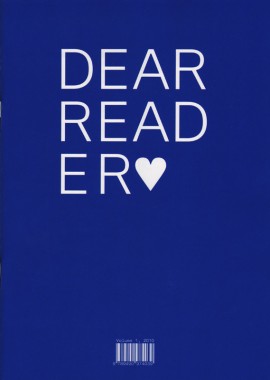
Dear Reader, Vol. 1
Softcover, 36 pp., offset 2/2 + spot varnish, 210 x 297 mm
Edition of 500
ISSN 2211-1085
ISBN 978-94-90974-03-9
Published by Carvalho Bernau
$13.00 · out of stock
A collection of obsessions, oblique references and footnotes of design processes — though not necessarily texts about design. The layout is appropriately diverse and eclectic for the bandwidth of texts, layering different formats and texts, as a tongue-in-cheek reference to the design shtick of publications with different paper formats. Here we present three iconic formats in emphasized-as-fake three-dimensionality, on four different papers and more inks than you would think.
Dear Reader was created partly from a primordial graphic designers’ urge to publish something and to share texts that are dear to us, partly in celebration of Atelier Carvalho Bernau’s approximate fifth anniversary, and partly as a vessel to showcase our type design work in a manner that circumvents the conventions and the visual clichés of the type specimen.
Adolf Loos, AG Fronzoni, Barbara Wright, Carvalho Bernau, Design, Distribution, El Lissitzky, Frederico Duarte, John Cage, Kai Bernau, Morton Feldman, Raymond Queneau, René Hague, Susana Carvalho, Typography
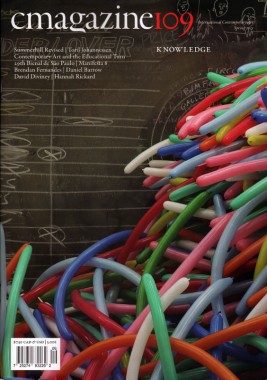
C Magazine 109, Knowledge
Softcover, 56 pp., offset 4/1, 210 x 295 mm
Edition of 2200
ISSN 1480-5472
Published by C Magazine
$7.50 ·
Issue 109 of C Magazine, Knowledge, includes an essay by Jen Kennedy, School’s In: Contemporary Art and the Educational Turn, that examines Jennifer Dalton and William Powhida’s #class, Anton Vidokle’s unitednationsplaza and Night School, and projects recently conducted at the Copenhagen Free University, and a feature article by Sholem Krishtalka, “You and Me and Her and Us and Them: A Conversation on Using and Being Used,” about collaborating with novelist Sheila Heti and painter and filmmaker Margaux Williamson. This issue also includes an interview by Mandy Ginson with Toril Johannessen, exploring some of the ways Johannessen engages scientific methods of analysis and models of classification and display in her work, as well as two artist projects; Summerhill, Revised, by Helen Reed and Hannah Jickling with an accompanying text by Stephanie Springgay, and Studies for Possible Futures by Maggie Groat. Issue 109 also includes reviews of the 29th Bienal de São Paulo and Manifesta 8, as well as book reviews and exhibition reviews from cities including Fredericton, Halifax, Hamilton, Ottawa, Toronto and Vancouver.
Anton Vidokle, Art, C Magazine, Distribution, Hannah Jickling, Helen Reed, Jen Kennedy, Jennifer Dalton, Maggie Groat, Mandy Ginson, Margaux Williamson, Sheila Heti, Sholem Krishtalka, Stephanie Springgay, Toril Johannessen, William Powhida

Dispatches and Directions: On Artist-Run Organizations in Los Angeles
Edited by Ronni Kimm and Jesse Aron Green
Softcover, 160 pp., offset 2/2, 9 x 9 inches [24 x 36 inches unfolded]
4 part book + poster
Edition of 500
ISBN 978-0-615-39970-6
Published by ART2102
$20.00 · out of stock
Over the past several years ART2102 has acted as a platform for artists and curators in Los Angeles to realize their projects and exhibitions. From its space in Boyle Heights, ART2102 hosted a vibrant program known for its open cultural discourse and flexibility of ideas, and for engaging both local and international artists at various stages in their careers. Gradually, ART2102 moved away from this physical site as its programming and initiatives engaged with the large network of other artists-run spaces across Los Angeles and Southern California.
Dispatches and Directions, the final publication and project of ART2102, does not simply document this history, but also emulates the organization’s role as a platform and a network by spotlighting a number of the artists-run collaborations that are currently active in Los Angeles, and that will continue to thrive as ART2102 recedes. The publication not only provides a space in which these organizations can describe their work, but will also look at the legacy of ART2102 in light of the diverse range of programming emulated by these groups.
The publication, edited by Ronni Kimm and Jesse Aron Green, features contributions from various artist-run projects, including, Artist Curated Project, ESL, Genesis Project, Los Angeles, MATERIAL, Monte Vista, Slab, Telic Arts Exchange, Wildness. Also included are thoughts and anecdotes from Kate Fowle, Rika Hiro, Songmi Huff, Thomas Lawson, Paul McCarthy, Yoshua Okon, Renaud Proch and Erlea Maneros Zabala; an essay by Sarah Lehrer-Graiwer; a directory of over 60 artist-run and non profit organizations; and a specially commissioned “Star Chart” to help navigate the scene, by artist Jim Skuldt. The publication was designed in collaboration with Willem Henri Lucas.
Art, ART2102, Artist Curated Project, Distribution, Erlea Maneros Zabala, ESL, Genesis Project, Jesse Aron Green, Jim Skuldt, Kate Fowle, Los Angeles, MATERIAL, Monte Vista, Paul McCarthy, Renaud Proch, Rika Hiro, Ronni Kimm, Sarah Lehrer-Graiwer, Slab, Songmi Huff, Telic Arts Exchange, Thomas Lawson, Wildness, Willem Henri Lucas, Yoshua Okon
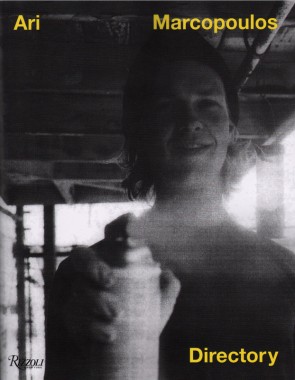
Ari Marcopoulos, Directory
Softcover, 1200 pp. + signed print, offset 1/1, 215 x 275 x 70 mm
First edition
ISBN 978-0-8478-3532-4
Published by Nieves
out of print
Ari Marcopoulos’s unique style of raw immediacy has made him one of the most important contemporary photographers. For thirty years, photographer Ari Marcopoulos has been pioneering contemporary photography by documenting subcultures such as skateboarders and graffiti artists, as well as landscapes and his own family and friends. Since his days printing photographs for Andy Warhol, he has amassed a huge body of work marked by its arresting and unsentimental intimacy that has been influential to the worlds of art, fashion, and photography. Bound to mimic a phone book, Ari Marcopoulos, Directory presents a collection of approximately 1,200 photographs, with curator and critic Neville Wakefield providing insightful commentary on some of Marcopoulos’s singular images. Copublished with Rizzoli, each book in this limited-edition series includes a print signed by the artist.
Ari Marco, Culture, Dung Ngo, Graffiti, Julie Schumacher, Neville Wakefield, Nieves, Photography, Rizzoli
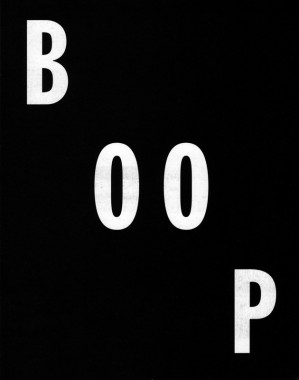
Ray Johnson and Bill Wilson, A Book About A Book About Death
Softcover, 58 pp., offset 1/1, 160 x 200 mm
Edition of 500
ISBN 978-94-90629-01-4
Published by Kunstverein
$15.00 · out of stock
Ray Johnson wrote poetic texts and letters and integrated language and a unique system of cryptic signs into his work. Considered by many the ‘father of Mail Art’, as early as 1953 Johnson began sending highly conceptual images/texts to friends, often encouraging the recipient to ‘add to’ the work, or ‘please send to’ someone else, or ‘return to Ray Johnson’. Forming the ‘New York Correspondence School’ in 1962, Johnson established an enormous network of participants throughout the world — one that remains active even after his death. Between 1963 and 1965, Ray Johnson printed thirteen pages of his book about death with the Pernet Printing Company, 120 Lexington Avenue at 28th Street. His title, which designated the thirteen unbound pages as a book, is A Book about Death, yet also A Boop about Death and A Boom about Death.
In “A Book About A Book About Death” close friend and author Bill Wilson elaborates on each of the pages of “A Book about Death”.
Art, Bill Wilson, Culture, Distribution, Germaine Kruip, Jaan Evart, Krist Gruijthuijsen, Kunstverein, Marc Hollenstein, Maxine Kopsa, Ray Johnson, Stephen Serrato, The Mondrian Foundation
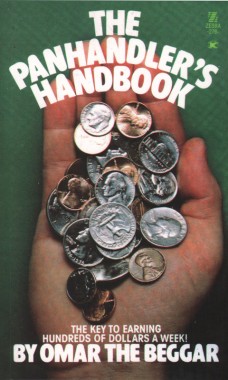
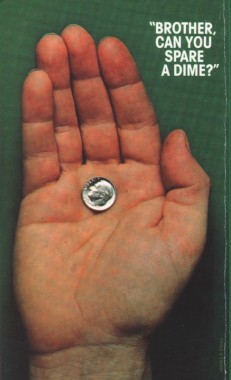
Omar the Beggar, The Panhandler’s Handbook
Softcover, 176 pp., offset 1/1, 105 x 175 mm
Edition of 500
ISBN 978-94-90629-05-2
Published by Kunstverein
$15.00 · out of stock
This publication is a reprint of the
original The Pandhandler’s Handbook which was published by Kensington Publishing Cooperation in 1977.
Omar Rockford, founder of Omar’s School for Beggars, teaches out-of-work men and women how to creatively panhandle for a living. Successful, high-income begging on the streets requires imaginative deception. Omar demonstrates hundreds of foolproof methods in this handbook. You’ve got to have a glib tongue, a sense of urgency and a believable story – also proper dress and courtesy are a must. The first few weeks can be rough, since one isn’t easily adjusted to the embarrassment of being turned down. It takes about a month to become a real pro and practice does make perfect. With this practical guide, you’ll never need to work a real job again,
Alan Abel, Art, Culture, Distribution, Jaan Evart, Kensington Publishing Cooperative, Kunstverein, Omar Rockford, Omar the Beggar, The Mondrian Foundation
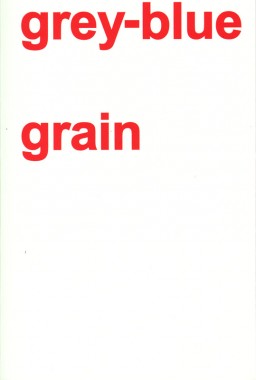
Adam Pendleton, grey-blue grain
Softcover, 80 pp., offset 1/1, 120 x 180 mm
Edition of 250
ISBN 978-94-90629-06-9
Published by Kunstverein
$18.00 · out of stock
Adam Pendleton composes formal templates in which he slots information, shifting language, forms and images into an arena of artistic inquiry. Practicing extreme freedom of reference and quotation, as well as a rejection of conventional hierarchies among sources, Pendleton establishes new referential devices and displays in which he exploits the easy-psychology of biographical readings, rendering language and image both concrete and contingent. grey-blue grain comprises of a series of writings used and appropriated in previous works and performances.
Adam Pendleton, Amiri Baracka, Art, Distribution, Edward Sapir, Hugo Ball, Jaan Evart, Jean-Luc Goddard, Jena Osman, Joan Retallack, Kunstverein, Leroi Jones, Leslie Scalapino, Marc Hollenstein, Ron Silliman, Tan Lin, The Mondrian Foundation

Garamond Press, False Friends
Hardcover, 48 pp., offset 1/1, 115 x 185 mm
English, French, and Dutch
Edition of 500
ISBN 0 978-94-90629-02-1
Published by Kunstverein
$18.00 ·
Antonio Pigafetta’s questionable travelogue from 1591, titled Regnum Congo, was based upon stories from Duarte Lopez, a Portuguese explorer who supposedly visited the Congo. The travelogue introduces an odd vision of European landscape in which fantastic creatures are presented. South-African artist Ruth Sacks re-contextualizes these historical interpretations by re-appropriating them into contemporary conditions, juxtaposing the varied characteristics. Hence the logo of her fictional publishing house, Garamond Press: a fantastic animal based upon a description of one of the possible animals from Regnum Congo. The narrative of the book False Friends derives from the storyline of Edgar Allen Poe’s Murders at the Rue Morgue from 1841, generally agreed to be the first detective story ever written. This contemporary version is set in Antwerp, Belgium, and is split into three languages: Dutch (Flemish), French and English. To follow the story’s plot, one has to be fluent in all three languages.
Anne Millar, Antonio Pigafetta, Art, Design, Distribution, Duarte Lopez, Edgar Allen Poe, Fiction, Garamond Press, Jaan Evart, Kunstverein, Marc Hollenstein, Ruth Sacks, Stephen Serrato

Nedko Solakov, High Level Margins With A Catalogue
Softcover, 112 pp., offset 1/1, 200 x 165 mm
Edition of 100
ISBN 978-94-90629-04-5
Published by Kunstverein
$28.00 ·
This publications has been produced as part of the exhibition “High Level Margins With A Catalogue” by Nedko Solakov (18 September — 21 November 2010) and serves as a reading device for the stories as a reading device for the stories displayed on and around the margins of Kunstverein’s 3.5 m high ceiling.
Art, Distribution, Jaan Evart, Kunstverein, Nedko Solakov, The Mondrian Foundation
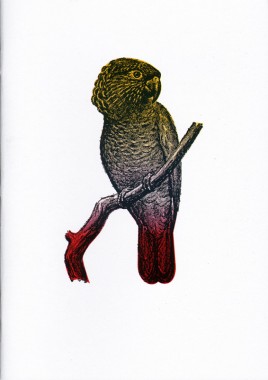
Ginger&Piss 2, Gay
Softcover, 32 pp., offset 1/1, 140 x 200 mm
Edition of 200
ISBN 978-94-90629-03-8
Published by Kunstverein
$21.00 ·
Ginger&Piss is a cross between an academic journal and a darts club newsletter. The journal (falsely quoting Lawrence Weiner) is published twice yearly, and starts off in a limited run. Each issue contains a maximum of 5 or 6 contributions, of any length necessary.
The idea behind Ginger&Piss is to offer an outlet for authors to say what they feel is vital (and not necessarily at all related to the art world). The concept dictates that each contributor writes under a pseudonym. We–the editors–guarantee full privacy. We see the use of pseudonyms as an answer to the cowardice of the art world, be it a somewhat hypocritical answer. By allowing a platform to exist for candid critique but at the same time by still letting the author hide behind a pseudonym, we recognize our own cowardice. In fact, Ginger&Piss fully embraces its somewhat misleading bravery, but we think it makes sense for now, for the current cultural climate.
Gay is the “subject” of the second issue of Ginger&Piss and continues the magazine’s flirtation with all-purpose (non) themes. As a verb and as an expression (and maybe even a curse) Gay may appear less one-dimensional than Loud (Ginger&Piss’ first theme. Flamboyantly exhibited as internal swagger and compulsive paranoia, the articles in this issue continue Ginger&Piss’ journey towards immaculate speculation.
Álvaro Coelho de Athayde II, Art, Coco de Moll, Distribution, Ginger&Piss, Harrison Haymarket, Krist Gruijthuijsen, Kunstverein, Lylah Clare, Marc Hollenstein, Maxine Kopsa, Meredith Morris, R. J. Vanderhorst, T. Gidley, The Mondrian Foundation
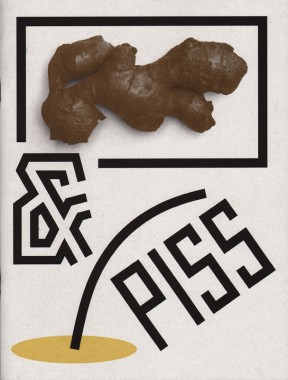
Ginger&Piss 1, Loud
Softcover, 22 pp., offset 4/1, 210 x 275 mm
Edition of 200
ISBN 978-94-90629-03-8
Published by Kunstverein
$21.00 ·
Dear Reader,
Ginger&Piss is Kunstverein’s in-house magazine — a cross between an academic journal and a darts club newsletter. Ginger&Piss (the name a misquotation of Lawrence Weiner) is published twice yearly, with the first edition appearing in a short run. Each issue contains a maximum of five or six contributions of varying length, appropriate to the individual subject matter.
The remit of Ginger&Piss is simple: to offer an outlet for authors to say what they feel is vital (and not necessarily at all related to the art world) but were unable, unwilling or too afraid to publish previously. The concept dictates that each contributor writes under a pseudonym. We — the editors — guarantee full anonymity.
Loud is the subject of the first issue and it is a broad — probably far too broad — theme (if a them at all). In fact Quiet might have been more appropriate. But we at Ginger&Piss think a clear, ‘honest’ voice is better suggested by volume than whispering.
— Krist Gruijthuijsen and Maxine Kopsa
Anonymous, Art, Billy Male, Distribution, Elvira Belafonte, G. Alonso Oeuf, Ginger&Piss, Hula Capellinni, Krist Gruijthuijsen, Kunstverein, Marc Hollenstein, Maxine Kopsa, T. Gidley, The Mondrian Foundation













